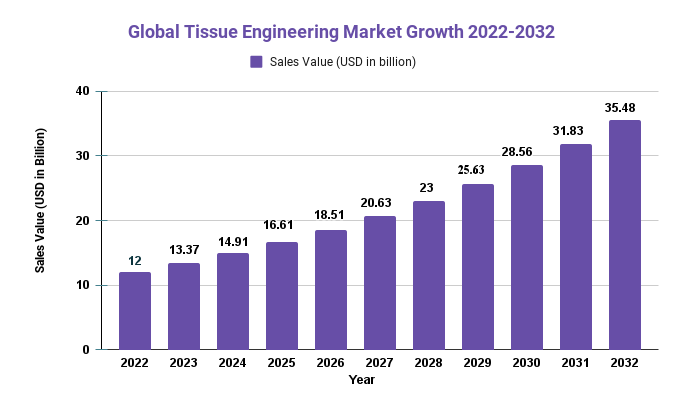Tissue Engineering Market To Develop Speedily With CAGR Of 11.45% By 2032

Page Contents
Tissue Engineering Market Overview
Published Via 11Press:
The global tissue engineering market size is expected to be worth around USD 35 Bn by 2032 from USD 12 Bn in 2022, growing at a CAGR of 11.45% during the forecast period from 2023 to 2032.
The tissue engineering market is rapidly growing. As new technologies emerge, the global market for tissue engineering products continues to expand and reach a wide range of sectors. From medical devices to biopharmaceuticals, tissue engineering has become an essential tool in many areas of research and development.
Tissue engineering is a relatively new field that involves the replacement or repair of damaged tissues by combining biological materials with other technological elements. This technology has revolutionized the way medical professionals treat injuries and diseases, leading to improved patient outcomes and increased quality of life for patients around the world. Furthermore, tissue engineering can be used for regenerative medicine applications such as organ replacement or stem cell therapy. With its wide range of potential applications, it is no surprise that investments in this sector have been increasing in recent years.
The increasing demand for replacement tissues due to the rising number of chronic diseases is one of the major drivers for the tissue engineering market growth. Moreover, technological advancements have allowed scientists to create artificial substitutes for bone, muscle and other bodily tissues using 3D printing technologies. Additionally, the growing geriatric population across the globe will also drive this market's growth during the forecast period.
Furthermore, governments in many countries are providing funds and grants for research activities related to tissue engineering which will boost this industry's expansion over time.

Key Takeaways
- The tissue engineering market is a rapidly growing field that involves the use of living cells and materials to create functional tissues and organs.
- The market is being driven by factors such as increasing demand for regenerative medicine, rising prevalence of chronic diseases, and advancements in tissue engineering technologies.
- North America is the largest market for tissue engineering, due to factors such as favorable government initiatives, increasing R&D investments, and a well-established healthcare infrastructure.
To Gain greater insights, Request a sample report @ https://market.us/report/tissue-engineering-market/request-sample/
Regional Snapshot
The tissue engineering market has been experiencing substantial growth over the past few years due to advancements in regenerative medicine and biotechnology. With new developments in stem cell research, nanotechnology, and biomaterials, the global tissue engineering market is expected to grow significantly. This article provides an extensive regional analysis of the market.
Based on region, North America is anticipated to dominate the global tissue engineering market during the forecast period. Factors such as the presence of well-developed healthcare infrastructure, and increasing government initiatives for investing in healthcare technology and services are driving the growth of this region. Additionally, the high prevalence rate of chronic diseases in countries such as the U.S., and Canada are further stimulating demand for advanced medical treatments including tissue engineering that can help improve the quality of life for patients with these conditions.
Drivers
The tissue engineering market is undergoing rapid growth, as advancements in the field continue to revolutionize treatments for a variety of diseases and medical conditions. In particular, the introduction of new materials and technologies is driving global market growth. tissue engineering market is a key component of this expanding market, as they have enabled researchers to develop more effective treatments with fewer side effects.
Biomaterials such as hydrogels, nanofibers, and scaffolds have been used to enhance tissue repair and regeneration. For example, 3D scaffold systems can be used to deliver cells or drugs directly into damaged tissue areas with greater precision than traditional methods. The development of these materials has opened up many possibilities for tissue engineering applications across various sectors including healthcare, agriculture, and cosmetics.
As regenerative medicine becomes more widespread, its use will become increasingly important within the healthcare sector. The demand for tissue-engineered products such as skin grafts, bone substitutes, and organ replacements has risen significantly over recent years due to their effectiveness in treating conditions such as burns or chronic wounds. Furthermore, advancements in material science have allowed for better-engineered tissues with proper structural integrity that are matched to each patient’s needs more efficiently than ever before.
Restraints
The tissue engineering market is a rapidly growing industry, but there are some restraints that can affect its growth. refers to the various biological and mechanical components used for fabricating and repairing tissues in the body. Despite the promising potential of these products, a few factors have been identified as bottlenecks in their widespread adoption.
One of the primary challenges faced by the tissue engineering market is the high cost associated with developing and manufacturing these products. The difficulty in acquiring materials and resources required for tissue culture also contributes to this issue. Furthermore, inadequate regulatory frameworks in many countries make it difficult to assess product safety and efficacy before they enter into clinical trials or commercialization stages. This further increases costs since companies have to bear additional expenses toward compliance guidelines. Additionally, inadequate technical expertise and lack of awareness regarding the use of tissue engineering are also major deterrents to its widespread adoption.
Challenges
One of the primary challenges faced by the tissue engineering market is creating cost-effective treatments for various diseases or conditions. While current techniques can provide relief from certain issues, they often come with hefty price tags that many patients cannot afford. Another challenge lies in developing methods to produce high-quality tissues on a large scale without compromising their integrity or purity levels. Finally, researchers must find ways to ensure ethical standards are met and patient safety is upheld during all stages of development and implementation.
Opportunities
The tissue engineering market is an ever-growing industry that offers a wide range of opportunities for investors and entrepreneurs. With the advances in regenerative medicine and biotechnology, tissue engineering has become a major player in the healthcare industry. From 3D printing to cell therapy, companies are exploring innovative methods to revolutionize healthcare through advances in tissue engineering technology.
This field provides immense potential for business growth as there is still much research left to be done when it comes to uncovering how best to use engineered tissues or organs within medical treatments. Companies have already developed 3D-printed bones, artificial skin grafts, dental scaffolds, and more – all of which provide promising results in clinical trials. It is expected that these technologies will become more sophisticated as research continues and new applications are discovered.
Interested to Procure the Data? Inquire here at https://market.us/report/tissue-engineering-market/#inquiry
Recent Developments
- In 2020, researchers at the University of California, Berkeley developed a new 3D-printing technique for creating living tissues with embedded vasculature. The technique involves using a custom-built 3D printer to create a scaffold made of sugar and gelatin, which is then coated with living cells and grown in a culture medium.
- In 2021, a team of researchers from Japan and the United States announced that they had successfully transplanted lab-grown heart muscle cells into a macaque monkey. The study represents an important step forward in the field of tissue engineering, as it demonstrates the potential for lab-grown tissues to be used in humans.
- Also in 2021, scientists at the University of Nottingham announced that they had developed a new type of bio-ink for 3D printing that can be used to create complex structures such as blood vessels and nerves. The bio-ink is made from a mixture of natural materials, including alginate and collagen, and can be customized to suit the needs of different types of tissues.
Market Segmentation
Based on Type
- Synthetic
- Biological
- Others
Based on Application
Top Key Players
- Stryker
- Medtronic
- Allergan
- Baxter International
- Organovo Holdings Inc
- Zimmer
- Integra LifeSciences
- DePuy Synthes
- Cook Medical
- Acelity
- Other Key Players
Report Scope
| Report Attribute | Details |
| Market size value in 2022 | USD 12 Bn |
| Revenue forecast by 2032 | USD 35 Bn |
| Growth Rate | CAGR Of 11.45% |
| Regions Covered | North America, Europe, Asia Pacific, Latin America, and Middle East & Africa, and Rest of the World |
| Historical Years | 2017-2022 |
| Base Year | 2022 |
| Estimated Year | 2023 |
| Short-Term Projection Year | 2028 |
| Long-Term Projected Year | 2032 |
Contact us
Contact Person: Mr. Lawrence John
Market.us (Powered By Prudour Pvt. Ltd.)
Tel: +1 718 618 4351
Send Email: [email protected]
FAQ.
Tissue engineering is a field of biomedical engineering that involves the use of living cells and materials to create functional tissues and organs. The goal is to develop new treatments for a wide range of diseases and injuries.
Some of the key challenges facing the tissue engineering market include the need for better methods for scaling up the production of tissues and organs, the need for more effective ways of integrating lab-grown tissues into the body, and the need for better regulatory frameworks to ensure the safety and efficacy of tissue engineering products.
Tissue engineering has a wide range of applications, including regenerative medicine, drug discovery and development, and toxicology testing. It has the potential to be used to treat a wide range of diseases and injuries, such as heart disease, diabetes, and spinal cord injuries.
The tissue engineering market is expected to continue to grow in the coming years, driven by factors such as increasing demand for regenerative medicine, rising prevalence of chronic diseases, and advancements in tissue engineering technologies. However, the market is also likely to face challenges such as regulatory issues and ethical concerns.
The team behind market.us, marketresearch.biz, market.biz and more. Our purpose is to keep our customers ahead of the game with regard to the markets. They may fluctuate up or down, but we will help you to stay ahead of the curve in these market fluctuations. Our consistent growth and ability to deliver in-depth analyses and market insight has engaged genuine market players. They have faith in us to offer the data and information they require to make balanced and decisive marketing decisions.



